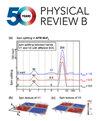Competing ordinary and Hanle magnetoresistance in Pt and Ti thin films
IF 3.7
2区 物理与天体物理
Q1 Physics and Astronomy
引用次数: 0
Abstract
One of the key elements in spintronics research is the spin Hall effect, allowing to generate spin currents from charge currents. A large spin Hall effect is observed in materials with strong spin-orbit coupling, e.g., Pt. Recent research suggests the existence of an orbital Hall effect, the orbital analog to the spin Hall effect, which also arises in weakly spin-orbit-coupled materials like Ti, Mn, or Cr. In Pt both effects are predicted to coexist. In any of these materials, a magnetic field perpendicular to the spin or orbital accumulation leads to additional Hanle dephasing and thereby the Hanle magnetoresistance (MR). To reveal the MR behavior of a material with both spin and orbital Hall effect, we first study the MR of Pt thin films over a wide range of thicknesses. Careful evaluation shows that the MR of our textured samples is dominated by the ordinary MR rather than by the Hanle effect. We analyze the intrinsic properties of Pt films deposited by different groups and show that next to the resistivity also the structural properties of the film influence which MR dominates. We further show that this correlation can be found in both spin Hall active materials like Pt and orbital Hall active materials, like Ti. For both materials, we find a large Hanle MR for the samples without apparent structural order, whereas the ordinary MR dominates in the crystalline samples. We then provide a set of rules to distinguish between the ordinary and the Hanle MR. We suggest that in all materials with a spin or orbital Hall effect the Hanle MR and the ordinary MR coexist and the purity, crystallinity, and electronic structure of the thin film determine the dominating effect.求助全文
约1分钟内获得全文
求助全文
来源期刊

Physical Review B
物理-物理:凝聚态物理
CiteScore
6.70
自引率
32.40%
发文量
0
审稿时长
3.0 months
期刊介绍:
Physical Review B (PRB) is the world’s largest dedicated physics journal, publishing approximately 100 new, high-quality papers each week. The most highly cited journal in condensed matter physics, PRB provides outstanding depth and breadth of coverage, combined with unrivaled context and background for ongoing research by scientists worldwide.
PRB covers the full range of condensed matter, materials physics, and related subfields, including:
-Structure and phase transitions
-Ferroelectrics and multiferroics
-Disordered systems and alloys
-Magnetism
-Superconductivity
-Electronic structure, photonics, and metamaterials
-Semiconductors and mesoscopic systems
-Surfaces, nanoscience, and two-dimensional materials
-Topological states of matter
 求助内容:
求助内容: 应助结果提醒方式:
应助结果提醒方式:


